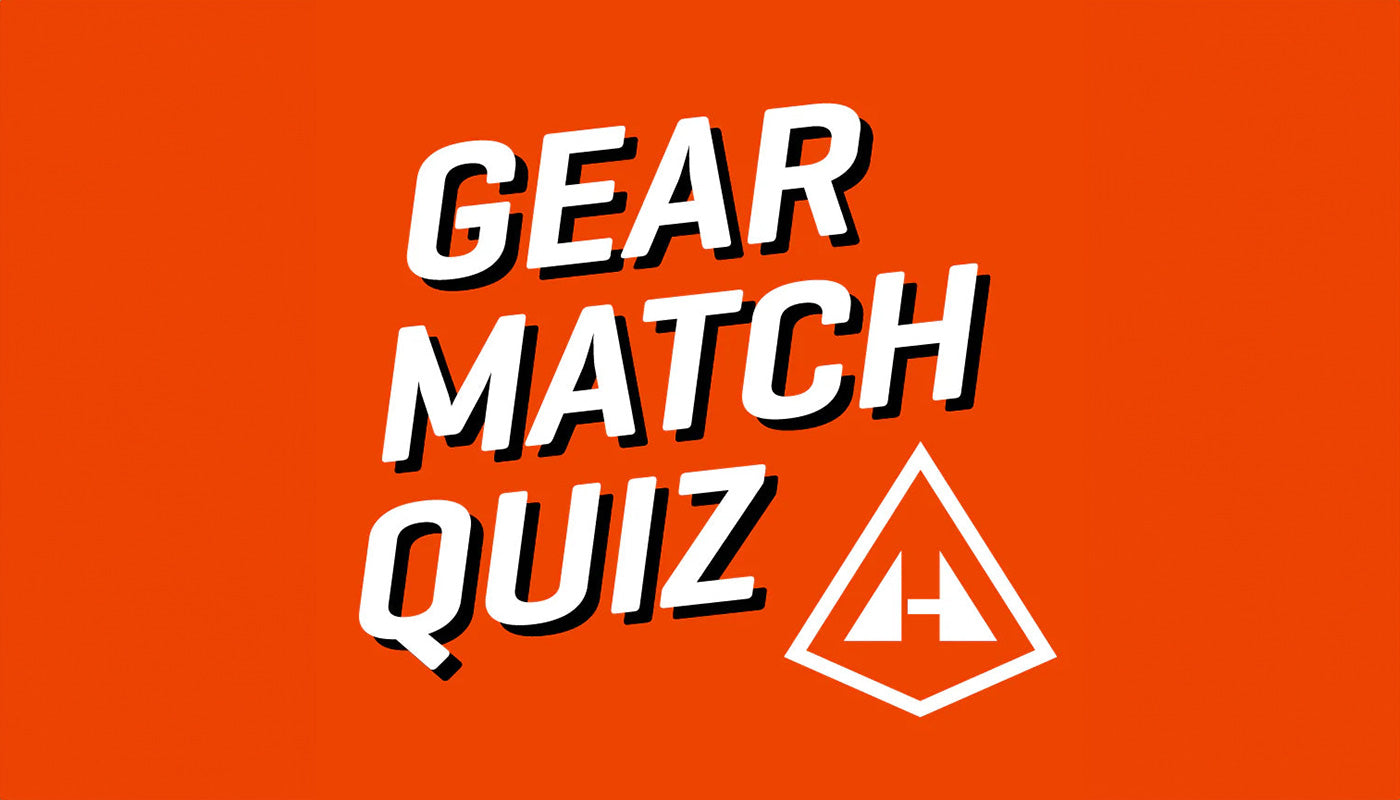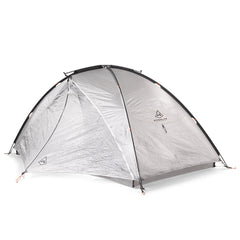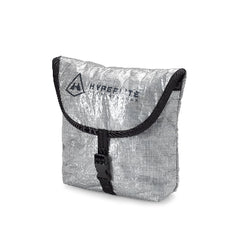Words and Photos by Michael DeYoung: IG @michaeldeyoung
Dawn alpenglow and pink cirrus clouds above the high peaks of the Cordillera Huayhuash from Laguna Carhuacoacha.
We have logged countless backpack and wilderness river trips over the past forty years together throughout Alaska, Arctic Canada, the Western U.S., and beyond. Like the usual committed-to-the-core backcountry purist, self-planned, self-supported, and muscle-powered "do everything yourself" trips were all we knew. The rewards and satisfaction were immeasurable.
Is it possible to indulge in a wilderness "luxury" trip without diluting our hard-core backcountry bona fides? Not only, "You betcha!" but it was long overdue! Why not splurge a little for a 35th-anniversary celebration? So that's what we did. In September of 2023, Lauri and I did a custom-outfitted multi-day mountain trek to the high Andes of northern Peru. If you like a complete immersion into world-class big mountain landscapes with beautiful glacier lakes, then you will love a trek around and amongst the giants of the Cordillera Huayhuash.
This place is kind of off the beaten path compared to the very popular Inca Trail near Machu Picchu or the W Trek in Patagonia. It's also kind of legendary. Cordillera is the Spanish word for mountain range. The north-south oriented Huayhuash Range contains some of the highest peaks in the Andes, including the second highest in Peru, behind Huascaran, with six peaks over 6000 meters (19,685'), including Siula Grade 6,344 meters (20,814 ft) where the harrowing survival story, Touching the Void, took place in 1985. Today, an international clientele of trekkers walk around and through these massive peaks on eight to twelve-day hikes, and alpine climbing still takes place in the region. Few places offer equal or better dramatic mountain landscapes than the Cordillera Huaywash. Most of the trek is above trees, and sweeping open views are abundant. You will be sleeping and hiking at altitudes from 13,500' to almost 17,000' if you choose to tackle some of the highest passes along the alpine route.

Our view from Trapecio Pass, our highest pass with stratus clouds creating visual interest below the 18, 543' Nevado Cuyoc.
You can do this trek on your own as a self-supported backpack trip or with an outfitter that carries most of your camping gear and performs all the camping chores for you. Rather than choosing a well-known international adventure travel company, we chose to go with a local, family-owned outfitter, and there are several you can hire directly from Huaraz, the gateway adventure town in the Ancash region of north-central Peru. Regardless of how you do it, a trek here is not easy. It's still camping, and even in the good season, you are still subjected to typical mountain weather that can go south in a flash. Even "slackpacking," we chose to go as ultralight as possible with our pack, protective clothing, and water as much as possible.
There are lots of blogs written about how to do self-supported backpack trips here in the Cordillera Huayhuash and the nearby Cordillera Blanca in Huascaran National Park. Not all, though, are good, and not many show a solid grasp of ultralight backpacking principles, so I don't want to re-hash what's already been written about. While we certainly have the gear, experience, and physical ability to have backpacked the 10-day trek on our own, I am so glad we chose to go with a local and reputable guide. It was worth every penny. Not every wilderness trip has to be about "on the cheap." Splurging once in a while has benefits, and the guide fees were reasonable, and virtually all of the dollars we spent went directly into the local communities and not into corporate coffers.

Self-portrait overlooking Laguna Carhuacoacha at sunrise with the Elevate 22 pack.
One of my primary goals was to capture gallery-quality landscape images, and backcountry mountain' scapes are my favorite. As an aging pro photographer who still carries a mirrorless camera with interchangeable lenses, ultralight hiking is still important to me. Going with an outfitter allowed me to carry a day pack, including my "must have" camera gear, with a more comfortable and manageable weight. I can't make my camera outfit much lighter, but focusing on high-performance light gear and apparel everywhere else makes camera-toting much easier–about 10 pounds with extra clothes, snacks, and water.
My pack of choice was the Elevate 22, size large, and my absolute favorite "must have" piece of hiking gear the Camera Pod, also large. This is the best ultralight chest holster for carrying a light adventure camera outfit I've ever used. My camera is always ready, and the Pod really keeps my gear protected when the sky unloads on you, which it did several times on this trip. Having camp set up and broken for us gave me more time for creative exploration with my camera.

Me with my full pack at Paso Yaucha. Cordillera Huayhuash trails were no better or worse than many mountain trails we've hiked in the Rockies, Sierra, Cascades or the Chugach. Trails were a mix of nice firm dirt, rocky, muddy and trenched out in spots. For the seasoned hiker I would rate the trails as intermediate. The only real issue here is the altitude. Mountain weather is unpredictable and it is no different in this part of the Andes even though they are in the tropics.

Lauri and me ascending the iconic Siula Punta overlook.
After a fabulous sunrise the light went south by 10AM. Both Lauri and I are carrying Hyperlite Mountain Gear Elevate 22 packs that only weigh 1.5lbs empty - an ultralight pack for sure! | carry a mirrorless body with attached lens (Canon R7 with Canon 14-35/14 L lens) in my Camera Pod as a chest pouch.
The Cordillera Huayhuash are not on in a national park. The surrounding communities own them, and every day, we saw livestock, remote stone corals, and simple adobe huts where local ranchers stay when tending their animals. As such, all trekkers, including independent backpackers, are required to stay at designated camps where you pay a small fee that helps with the upkeep. All the camps had nice, grassy tent spots, a water source, and basic stone outhouses with a flush toilet, though not every one of the porcelain thrones worked. I thought it was amazing that most of them did, given the remote location. All but one of the camps we stayed at had million-dollar mountain views.
Unfortunately, one of the problems is "entitled" backpackers who think they can camp at large and avoid the established camps and the fees required to help support the local economy and maintain the camps for all users. We experienced this entitlement firsthand with one young couple backpacking the circuit on their own, and our guide gladly called them out for not respecting local customs and wishes. It's hard to believe that mentality still exists in the backpacker community.
Another benefit of going guided was a deeper cultural experience than we would have had as independent backpackers. Our guide, Adolfo, and his siblings, who own and operate Los Amigos de Huayhuash, grew up in the area on a farm in a very rural community and have hiked and climbed these mountains for much of their lives. As a result, we learned more about the region and the lives of people there through direct contact with our guides. In addition, he helped us with our Spanish and, of course, was a great interpreter when interacting with locals we came across on the trails.

This is the first of three glacial lakes, Laguna Gangrajanca, on the trail to Siula Punta that has a sweeping view of three lakes below towering peaks that makes an iconic photo of the Cordillera Huayhuash trek. Unfortunately, the weather went south quickly so my light went flat upon reaching the iconic overlook.
WHAT THE TREK WAS LIKE
Our trek was about 80 miles total miles in ten days, with ten days and one layover day. We didn't relax at all on our layover. Instead, we hiked up to a rarely visited alpine lake Adolfo knew about that other groups rarely visit. Most days were six to eight miles, but every day involved going over a 15,000’+ pass with two over 16,000', so the going was slow given the altitude. The energy output on a typical eight-mile day here was equivalent to 20-mile days on the PCT. This is not the place to "crush miles." We took our time to fully appreciate a place we traveled very far to reach. It was still physically taxing despite the low mileage. Our highest point was 16,800 at Trapecio Punta. I suffered a bit at that elevation, but the views and calm, sunny weather made it all worthwhile.

Wendy and Lauri at Punta Trapecio, our highest point on our trek at 16,800' looking at the somewhat obscured high peaks of the Cordillera Huayhuash.
The trail conditions varied from nice packed dirt to rock-strewn and muddy, with livestock poop everywhere, but not nearly as bad as Bright Angel Trail in the Grand Canyon, which has the worst animal smell of any trail. Trails were well-defined, and some resembled 4x4 backroads more than trails. The steepness and footing were no worse than anything we've hiked here in the U.S., including the Rockies, Sierras, Cascades, or the Chugach and Brooks Ranges in Alaska. There was no serious or concerning exposure anywhere on our trek.

Lauri De Young passes by a local rancher home near camp at Laguna Carhuacocha with a stone coral. We saw lots of these corals on our trek.
OUR OUTFITTER EXPERIENCE
Again, the outfitter we used was Los Amigos de Huayhuash, run by a local family of four adult siblings, and we could not have been happier. We had a crew of four people and seven animals–our primary hiking guide, Adolfo, a cook, and two camp hands/animal handlers for the three of us, Lauri, myself, and our good friend, Wendy. Our four-legged porters were a mix of donkeys, mules, and a rescue horse. Unlike the pack trains I've seen for years in the Rocky Mountains, none of the animals were tethered or strung together. The horse's purpose was to assist someone with altitude sickness or someone who is unable to walk for some reason and get them down in elevation as quickly as possible. Adolfo accompanied us every step of the hike and was extremely flexible and accommodating with my photography desires.
Meals and snacks were timely and good, given the remote locations we were in. We brought our own sleeping bags, pads, pillows, clothes, and personal items. Because we made all of those items as light as possible, they had no qualms about carrying my backup camera gear and tripod—pure luxury for me.
 Our cook hiked the same trails/route we did carrying a heavy pack to serve us a hot lunch and tea on real plates. Though we said it was OK for us to pack a lunch for the day, they insisted on providing this service. This is a level of "glamping" luxury that we are not accustomed to.
Our cook hiked the same trails/route we did carrying a heavy pack to serve us a hot lunch and tea on real plates. Though we said it was OK for us to pack a lunch for the day, they insisted on providing this service. This is a level of "glamping" luxury that we are not accustomed to.

Lauri DeYoung and Wendy Sailors enjoying ceviche' and coca leaf tea in the dining tent, part of the service provided by our outfitters, Los Amigos de Huayhuash on our 10-day trek.
DON'T GO WHEN WE WENT!
You can hike and backpack here year round but most go in our summer months June-August which is their winter months. Like most tropical locations, winter is the dry season and much more pleasant, though colder, for hiking. For sentimental reasons, we went from the beginning of the rainy season, late September, into October. While it didn't rain all day for days on end like we are used to in Alaska and the Washington Cascades, it rained A LOT, mostly in the afternoon and early evening. Good thing we are used to hiking in bad weather, having spent 35 years in Alaska. When we return for the next trip, it will be more toward the dry season. I'll take colder (and possibly snow) and drier over lots of rain any day.

When life gives you lemons, make lemonade! We were there at the beginning of the rainy season and rain it did! As a challenge, I photograph the experience and action, good or bad, not just the landscape. Lauri DeYoung and Wendy Sailors on the frequent muddy trail during a rainshower. I keep my camera in the Hyperlite Mountain Gear Camera Pod. It keeps my camera protected from the rain and allows quick access to capture moments like this.























